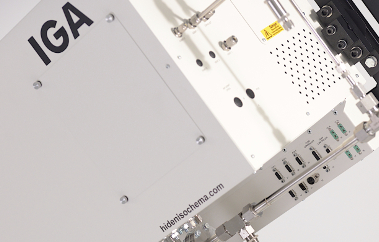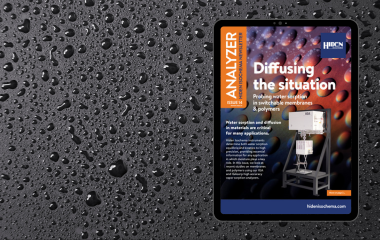In the Journal of the American Chemical Society, Stylianou et al have reported on the investigation of the structural transformation of a Zn-based flexible
Studying nitrogen dioxide adsorption in a MOF using XEMIS
A research article recently published in Nature Materials [1] reported the selective, reversible adsorption of NO2 by a metal-organic framework, MFM-300(Al), measured with a Hiden Isochema XEMIS-001 gravimetric sorption analyzer.
Nitrogen dioxide, NO2, is the most common oxide of nitrogen (NOx). It is produced and released by burning fossil fuels in internal combustion engines and other industrial processes, and is a significant atmospheric pollutant. Nitrogen dioxide is harmful to the environment as a greenhouse gas, and directly to human health as a toxic gas, with NO2 levels monitored in urban areas as a key marker for ambient air quality.
Adsorption of nitrogen dioxide offers a potential route to NO2 removal, but previously studied sorbents have shown relatively low NO2 adsorption capacity and often also irreversible uptake.
The authors of this article used gravimetric sorption measurements and breakthrough analysis, in combination with X-ray and neutron scattering structural techniques and other methods to measure the interaction of nitrogen dioxide with a metal-organic framework (MOF) developed at the University of Manchester, UK.
Gravimetric adsorption-desorption measurements with a range of different gases were measured using a XEMIS-001. The material, MFM-300(Al), exhibited high, reversible uptake for NO2, with the adsorption capacity being maintained over multiple cycles, demonstrating the robust nature of the MOF. The adsorption capacity for other atmospheric species including SO2, CO2, CH4, N2 and O2 was lower than for NO2, indicating high nitrogen dioxide adsorption selectivity. NO2 adsorption-desorption isotherms were measured at several temperatures, and the equilibrium data used in a thermodynamic analysis to obtain the isosteric enthalpy and entropy of sorption.
In the article, the authors comment that “isothermal adsorption of NO2 in MOFs has not been reported previously”.
The MOF’s selectivity for NO2 over other gas species was verified by breakthrough measurements with dilute NO2 under humid and dry conditions with a range of gas species. The breakthrough measurements were correlated with Ideal Adsorption Solution Theory (IAST) calculations using the gravimetric sorption isotherms.
Dr Sihai Yang, one of the study’s lead authors and a Lecturer in Inorganic Chemistry at the University of Manchester, UK, said: “Despite the highly reactive nature of nitrogen dioxide, our material proved extremely robust. It is the first example of a metal-organic framework that exhibits a highly selective and fully reversible capability for repeated separation of nitrogen dioxide from the air, even in presence of water.”
Professor Martin Schröder, another lead author from the School of Chemistry at the University of Manchester, commented, “Other studies of different porous materials found that they were unstable and decomposed with nitrogen dioxide, or that the regeneration process was too difficult and costly.”
Hiden Isochema’s Sales and Marketing Director, Dr Mark Roper said: “We are delighted to read this publication from our customers and learn more about the environmentally beneficial applications for this material and MOFs in general. It is especially pleasing to see XEMIS gravimetric sorption analyzers being used in such an important area and contributing to cutting edge research.”
For more information about Hiden Isochema’s XEMIS-001 used in the study, and other Hiden Isochema sorption instrumentation including the ABR automated breakthrough analyzer please contact us now!
Download the press release here.
[1] Reversible adsorption of nitrogen dioxide within a robust porous metal-organic framework
X. Han, H. G. W. Godfrey, L. Briggs, A. J. Davies, Y. Cheng, L. L. Daemen, A. M. Sheveleva, F. Tuna, E. J. L. McInnes, J. Sun, C. Drathen, M. W. George, A. J. Ramirez-Cuesta, K. M. Thomas, S. Yang and M. Schröder
Nature Materials 2018. DOI: 10.1038/s41563-018-0104-7


